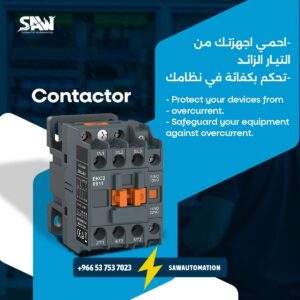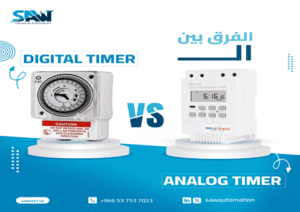What is a Multimeter: Types and Basic Uses

What is a Multimeter: Types and Basic Uses
Saw automation & electrical parts
When dealing with electrical faults or examining electronic circuits, the need arises for a precise tool that helps in quickly and efficiently discovering problems. Instead of using several separate devices to measure voltage, current, or resistance, many technicians and specialists rely on the “multimeter” device, which combines these functions in one tool. It is the primary choice in maintenance work and fault detection. Therefore, in this article, we will explain what a multimeter is, its types, and its most prominent uses. Let’s continue.
What is a Multimeter:
What is a multimeter? It is a multi-function electrical device used to measure voltage, current, and resistance in electrical and electronic circuits. It is also known as a “multimeter” or “Multimeter”. This device combines three main measuring devices in one tool:
Voltmeter: for measuring electrical voltage.
Ammeter: for measuring electrical current.
Ohmmeter: for measuring electrical resistance.
Key Uses of the Multimeter:
After learning what a multimeter is, we find that it is considered one of the most versatile and important tools for both professionals and hobbyists alike. It not only measures voltage, current, and resistance, but goes beyond that to become an effective tool in diagnosing faults, examining electronic components, and ensuring safety when working on electrical circuits. We will explore its key uses as follows:
Checking AC and DC voltage: To ensure that electrical outlets are working properly (such as verifying ~120 V in homes), and to measure various batteries (AA, 9 V, car batteries) and determine their charge level.
Measuring electrical current: Measuring the current of devices and components to determine if they are operating within safe limits (in conjunction with a shunt resistor or clamp attachments).
Testing resistance and continuity: Examining wires, switches, and plugs to determine if they are fully connected or broken (emits a beep when the circuit is fully closed), and measuring the resistance of resistors or wires to detect deviation from stated values.
Testing diodes: Determining if diodes are functioning correctly by passing a limited current and reading the voltage drop across them.
Measuring capacitance and frequency: For adjusting and operating capacitors within their designated range in circuits, then measuring the frequency of AC or pulsed signals in electronic applications.
Diagnosing household faults and electrical connections: Used in detecting live circuits, faulty connections, or blown fuses. It also helps in quickly and easily discovering faults in household appliances, such as: detecting a blown washing machine fuse or a broken power cord using the multimeter’s continuity mode.
Specialized tests in automobiles and HVAC systems: Checking battery charge, alternator condition, and circuit components in cars, and adjusting electrical components in heating, ventilation, and cooling systems (such as measuring fan capacitors and ensuring correct current flow).
Industrial and research applications: Engineers use it in laboratories to ensure the performance of sensors, power supply lines, and precision device motors within required standards.
Types of Multimeters:
When discussing multimeters, we find a diverse range of models that differ in their functions, design, and accuracy. Each type is designed to suit specific needs, whether for simple home maintenance or professional testing in laboratories and industrial sites. The following are the most prominent types of multimeters:
1- Analog Multimeter:
The analog multimeter is a device that relies on a small built-in current meter to measure electrical current, where the needle moves on a graduated indicator to display the measured values. Although this type is not considered as sensitive as the digital multimeter when measuring voltage, it has a high sensitivity of up to 50 ohms (i.e., 50 microamperes), due to its low resistance during measurement.
However, the accuracy of its results is affected by several factors, most notably: the size of the indicator, needle vibration during measurement, accuracy of the printing axis, the need for zero calibration, and the number of available measurement ranges. This type of device may also cause measurement errors due to different viewing angles, known as parallax error.
2- Digital Multimeter (DMM):
The digital multimeter is an advanced type of measuring device that relies on a digital counter and LCD screen to display readings instead of the traditional needle and scale. This type is widely used due to its ease of reading values and high measurement accuracy. Although its cost is slightly higher than analog devices, it features many advanced characteristics such as the ability to record and store measurement results in memory, and even synchronize them with a computer.
It also does not depend on battery charge status for reading accuracy, provides high resistance against mechanical damage, offers multiple functions, and does not require zero adjustments. This device also has the ability to select measurement ranges manually or automatically, making it an accurate and effective tool in various electrical and electronic measurement applications.
Best Measuring Tools Available at SAW Company
SAW Company is one of the leading suppliers in Saudi Arabia in the field of electrical tools and industrial automation devices. It offers a wide range of high-quality measuring and testing tools designed to meet the needs of engineers and technicians in the industrial sector, maintenance, and system installation workshops. The store is distinguished by providing accurate devices from excellent brands, with outstanding technical support and fast service. We will present the best measuring tools as follows:
1- Sanwa YX3-361TR Analogue Multimeter
The Sanwa YX3-361TR Analogue Multimeter is a professional multi-function analog device, manufactured in Japan and renowned for its durability and high accuracy. It has been specifically designed for engineers and technicians who are looking for a powerful traditional tool that provides reliable measurements in field and industrial environments. Its key features include:
33-35 measurement functions operated via a 24-point rotary switch, including voltage measurements (DC and AC), current up to 0.25 A, resistance, decibel (-10 to +62 dB), battery testing, continuity, and even transistor amplification factor (hFE) measurement when using a separate attachment.
Zero-center meter for DC voltage, facilitating accurate distinction between positive and negative readings.
Visual and auditory continuity testing via an LED that lights up when resistance is less than 10 ohms, with an internal output voltage of about 3 V for easy identification of closed circuits.
Decibel measurement and low-frequency measurement (40 Hz – 20 kHz) with ±3% accuracy within AC voltage less than 50 V.
Robust body and practical design made of reinforced plastic, with a replaceable glass valve and 0.5 A/250 V protection fuse to ensure safety.
Multi-operation with different types of batteries (2 AA batteries + 1 9V battery), weighing about 290 g, making it lightweight and suitable for field bags.
2- Sanwa YX360TRF Analog Multimeter
The Sanwa YX360TRF Analog Multimeter from Sanwa Electric Instruments is characterized by Japanese manufacturing quality and a robust design with an integrated case. It is used for voltage, current, resistance, capacitance, and decibel measurements, and is distinguished by the following:
Shock-resistant and easy to carry with a protective cover that converts into a reading stand, and even includes space for probe storage.
Supports ±5 V and ±25 V measurements, facilitating accurate reading of positive and negative signals up to ±5% of full scale.
Can be connected to an HV-10T sensor for measuring high voltage up to 25 kV DC or hFE technology for measuring transistor amplification factor, enhancing its capabilities.
Internal protection through a replaceable fuse (250 V/0.5 A) to ensure device safety in case of exceeding maximum currents.
Operates on two AA batteries and weighs about 320 g, making it suitable for carrying and field use.
Most Frequently Asked Questions About What a Multimeter Is
How do you measure current using a multimeter?
The probe is connected in the “A” or “mA” position and must be inserted in series with the circuit. Otherwise, parallel connection may cause a short circuit and fuse explosion.
What is the difference between an analog and a digital multimeter?
The analog uses a needle to indicate on a traditional scale while the digital (DMM) reads values digitally on an LCD/LED screen, providing higher accuracy and additional functions.
Is the multimeter safe? And what are the safety precautions?
The multimeter is safe, but necessary precautions must be followed, such as: ensuring that the device and probes are in good condition and free of cracks, and checking the meter with a known voltage before starting, to ensure its safety.
In conclusion, we have explained what a multimeter is, learned about its working mechanism, its different types, in addition to its most prominent uses and the most important frequently asked questions about it, which clarifies that it is an essential tool indispensable in the fields of electricity, electronics, and maintenance.



